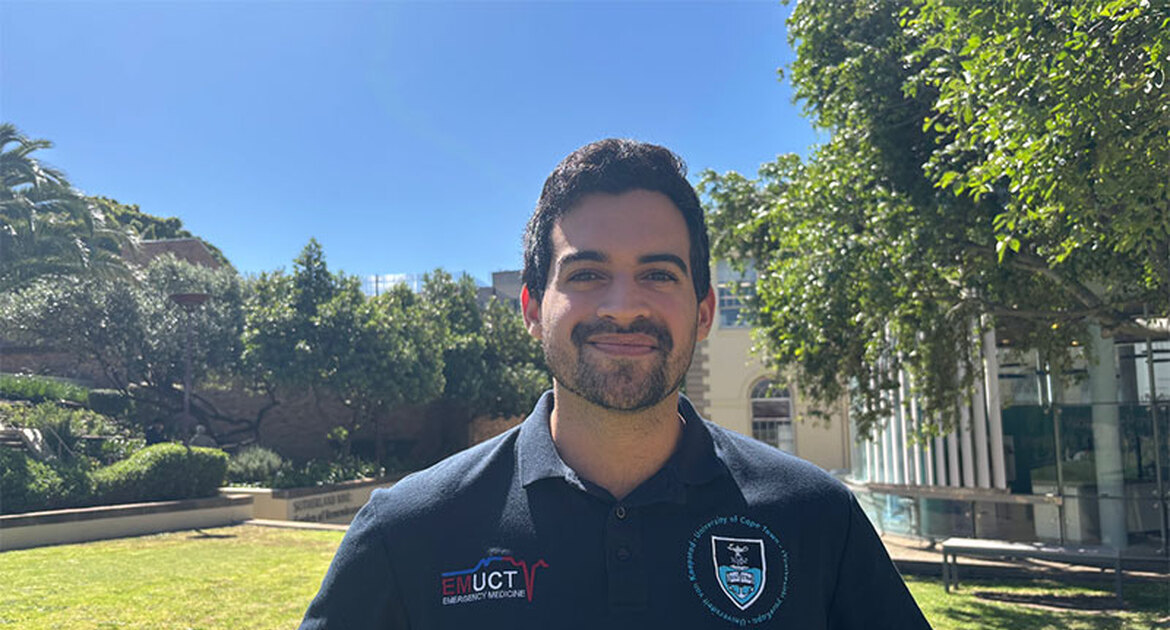IDM extension project boosts continent’s biomedical research capacity
14 November 2022 | Story Staff writer. Photos Lerato Maduna. Voice Cwenga Koyana. Read time 8 min.
In October 2022, the University of Cape Town’s (UCT) Institute of Infectious Disease & Molecular Medicine (IDM) officially opened the IDM North and South Pavilion extensions to the existing Wernher & Beit North (WBN) Building. These two modern pavilions are home to several new state-of-the-art core facilities, including an imaging platform, a molecular phenotyping centre and a data analysis centre, as well as new and much-needed shared office space – all essential to support the IDM’s burgeoning research enterprise.
The new IDM Pavilions were launched on 19 October, together with the African Microscopy Initiative (AMI) Imaging Centre – the biggest microscopy initiative in Africa’s history, and home to some of the world’s best optical microscopes, offering the most advanced imaging technology on the continent.
The AMI Imaging Centre facilities are available – at no cost – to scientists working for academic institutions and non-profit organisations across Africa, providing access to cutting-edge microscopy tools and expertise for life science and biomedical research, including human, plant and animal diseases, neuroscience, and many other biological disciplines.
This launch of the IDM Pavilions and AMI was particularly momentous as it coincided with the 110th anniversary of the founding of the Faculty of Health Sciences. In his address, faculty dean, Associate Professor Lionel Green-Thompson, sketched the history of microscopy across the world over centuries.
“This African Microscopy Initiative is the confluence of multiple legacies of invention, discovery, innovation, and creativity. But fundamentally, it is about the emergence of a spirit of partnership, collaboration and vision of this multipronged, continent-wide microscopy initiative.”
Reflecting historic buildings
Among other positive outcomes, the IDM Pavilions project – funded by the national Department of Science and Innovation (DSI), together with UCT and the IDM – will enable the continued hosting of the Cape Town component of the International Centre for Genetic Engineering and Biotechnology.
With approval from Heritage Western Cape and designed by KMH Architects, the pavilions are physically air-gapped from WBN. The sophisticated glass, steel and concrete IDM North and South Pavilions reflect the historic WBN Building, and contain four new shared open-plan office areas that can accommodate 120 academics, research staff, postdoctoral research fellows and postgraduate students.
The IDM’s intention is to use this new space to enable and support the growth of young research groups headed by associate members and fellows of the institute – groups who previously had no space allocation in the IDM complex, but who represent the next generation of research leaders in the infectious disease and molecular medicine fields.
The new pavilions also include two new and enabling research laboratories on the lower ground floor that are home to a state-of-the-art imaging platform, housing the AMI Imaging Centre and IDM Microscopy Unit, as well as the new Diplomics Centre for Molecular Phenotyping in Health Research. The location of these data-intensive core facilities places them adjacent to the newly created Data Analysis Centre, which consolidates bioinformaticians, computational biologists, data scientists and computing equipment from across multiple IDM member groups in the South Pavilion.
New, world-class microscopy initiative
The star at the launch was the AMI Imaging Centre, seen as a blueprint for transforming the continent by raising Africa’s role in global research through investments in science, technology, research, innovation, and world-class infrastructure. The centre will contribute to the delivery of the African Union’s Agenda 2063.
The multi-million-dollar facility was conceived by Dr Teng-Leong Chew, the director of the Advanced Imaging Centre at the HHMI AIC-Janelia , in collaboration with Digby Warner, Professor of Medical Microbiology, a member of the IDM and UCT lead partner in AMI, and was developed with IDM scientists.
The suite of microscopes in the AMI Imaging Centre was funded from grants provided by the Bill & Melinda Gates Foundation and the Chan Zuckerberg Initiative, supported by industry partners including Zeiss Microscopy and TissueGnostics. When combined with advanced analytical software, the images produced with these microscopes can be used in research that aims to tackle some of the continent’s most challenging problems, providing insights into how disease-causing bacteria bypass host defences to infect cells, and how damage to nerve cells can disrupt brain function.
Merging disciplines including physics, biology, chemistry, and data science, the AMI Imaging Centre ranks among the best-equipped microscopy facilities globally, providing technical and scientific support in addition to advanced instrument access.
Essential to Africa’s biomedical challenges
These high-technology research tools are essential to African scientists working on major biological and medical challenges, including infectious diseases such as TB, HIV and malaria, and non-infectious illnesses such as cancer, heart disease and diabetes – which together claim millions of lives annually.
The launch of the new IDM North and South Pavilions, through the Courtyard Extension Project, will support the Institute’s burgeoning world-class research.
Visiting scientists to the AMI Imaging Centre will have full access to advanced optical microscopes tailored for the life sciences, with high spatial and temporal resolution, to study a variety of biologies in both live and archival samples.
“Africa has until now been behind its global peers in microscopy, with under-funded institutions unable to afford state-of-the-art equipment,” said Professor Warner. “The opening of the Africa Microscopy Initiative is a huge step for continental research, innovation and scientific development.”
The centre will work closely with the African BioImaging Consortium and national and international imaging consortia to raise awareness of microscopy’s potential as a research tool. It will also act as a platform for African education, training and knowledge, and as a hub through which microscopy equipment may be distributed to research facilities across the continent.
Welcome investment in Africa
The AMI imaging centre has been highly anticipated and is long overdue on the continent, said Deputy Vice-Chancellor for Research and Internationalisation Professor Sue Harrison. In particular, the lack of world-class infrastructure resources in Africa has marginalised a large and important proportion of the global scientific community.
“To remedy this glaring inequity requires significant and sustained scientific research investment. It also spotlights the need to pave the way for African scientists to easily tap into many global scientific resources that are not equitably accessible. This is especially the case with microscopy.
“[AMI] is a bold venture that will enhance capacity for research that will preserve and enhance the lives of Africans and help them contribute to the world’s future.”
Adding to the development perspective, IDM director, Professor Valerie Mizrahi, said, “Tonight is all about our continent … As you can see [with this development], our collaborative footprint across Africa has grown enormously, and is set to grow even more.”
Already, 29% of the IDM’s postgraduate students and 47% of their postdoctoral research fellows come from other African countries, Professor Mizrahi said.
Professor Olatunji Sunday Yinka, the head of anatomy at Rwanda’s Adventist School of Medicine of East Central Africa, said, “AMI gives African scientists great access to tools equal to what is available in America and Europe. It strengthens African research capabilities and opens opportunities in what researchers can achieve with microscopes to solve different African challenges.”
 This work is licensed under a Creative Commons Attribution-NoDerivatives 4.0 International License.
This work is licensed under a Creative Commons Attribution-NoDerivatives 4.0 International License.
Please view the republishing articles page for more information.
Faculty of Health Sciences News




































